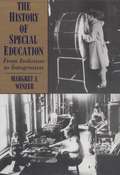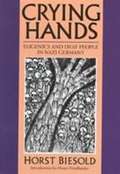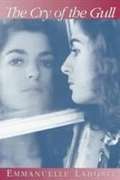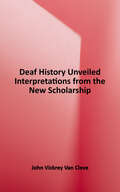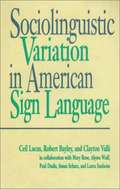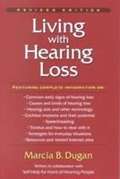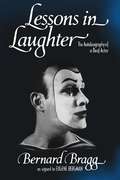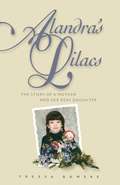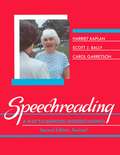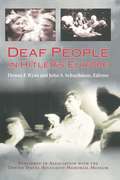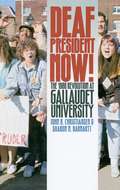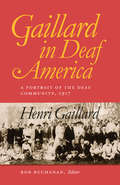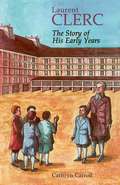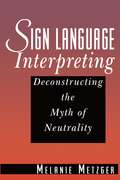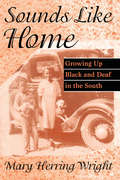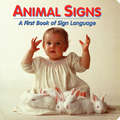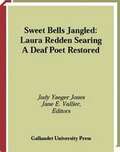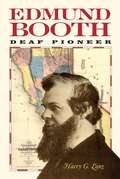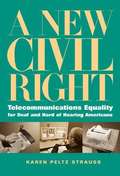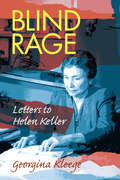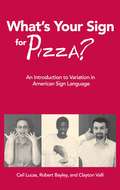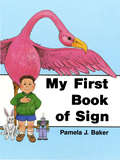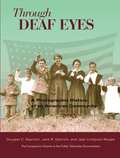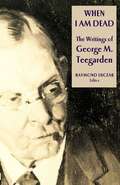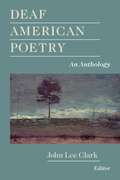- Table View
- List View
The History of Special Education: From Isolation to Integration
by Margret Winzer<p>This comprehensive volume examines the facts, characters, and events that shaped this field in Western Europe, Canada, and the United States. From the first efforts to teach disabled people in early Christian and Medieval eras to such current mandates as Public Law 94-142, this study breaks new ground in assessing the development of special education as a formal discipline. <p>The History of Special Education presents a four-part narrative that traces its emergence in fascinating detail from 16th-century Spain through the Age of Enlightenment in 17th-century France and England to 18th-century issues in Europe and North America of placement, curriculum, and early intervention. The status of teachers in the 19th century and social trends and the movement toward integration in 20th century programs are considered as well.</p>
Crying Hands: Eugenics and Deaf People in Nazi Germany
by Horst Biesold Williams SayersExposes the active collusion with the Nazis of various physicians, administrators, and teachers of the deaf who embraced the Third Reich's eugenics policies. Documents the collusion of deaf leaders, who tried to incorporate all independent deaf groups into one Nazi organization while expelling deaf Jews, and traces resistance against the Third Reich by deaf Germans. Includes personal accounts of some of the 1,215 deaf victims of enforced sterilization, demonstrating the lasting physical and emotional pain of Nazi violations. The author is a retired professor and teacher of deaf students.
The Cry of the Gull
by Emmanuelle Laborit Constantina Mitchell Paul Raymond CoteA memoir by a deaf, French actress who starred in the French production of Children of a Lesser God.
Deaf History Unveiled: Interpretations from the New Scholarship
by John Vickrey Van CleveDeaf History Unveiled features 16 essays, including work of Harlan Lane, Renate Fischer, Margret Winzer, William McCagg, and other noted historians in this field. Readers will discover the new themes driving Deaf history, including a telling comparison of the similar experiences of Deaf people and African Americans, both minorities with identifying characteristics that cannot be hidden to thwart bias. Other studies track societal paternalism toward deaf people in Italy, Hungary, and the United States. Adding to its intrigue, the new research in this milestone study provides evidence for previously uncredited self-determination of Deaf people in establishing education, employment, and social structures common throughout the Northern Hemisphere. Historians, teachers, and students will prize Deaf History Unveiled as a singular collection of insights that will change historical perspectives on the Deaf experience worldwide.
Sociolinguistic Variation in American Sign Language
by Ceil Lucas Robert Bayley Clayton ValliThis volume provides a complete description of ASL variation. People from varying regions and backgrounds have different ways of saying the same thing. For example, in English some people say "test," while others say "tes'," dropping the final "t. " Noted scholars Ceil Lucas, Robert Bayley, and Clayton Valli led a team of exceptional researchers in applying techniques for analyzing spoken language variation to ASL. Their observations at the phonological, lexical, morphological, and syntactic levels demonstrate that ASL variation correlates with many of the same driving social factors of spoken languages, including age, socioeconomic class, gender, ethnic background, region, and sexual orientation. Internal constraints that mandate variant choices for spoken languages have been compared to ASL as well, with intriguing results.
Living with Hearing Loss
by Marcia B. Dugan Howard E. StonePeople who are hard of hearing and their friends and relatives now can learn all they need to know about hearing loss in this easy to read guide. Newly updated and revised, Living with Hearing Loss takes the reader from A to Z on the kinds and causes of hearing loss and its common early signs. Written by Marcia B. Dugan, past president of Self Help for Hard of Hearing People (SHHH), this straightforward book provides thorough information on seeking professional evaluations and complete descriptions of hearing aids and other assistive technologies. Enhanced sections on the potential of cochlear implants and dealing with tinnitus distinguishes this very useful handbook. Readers also can take advantage of updated information on relevant Internet sites and a new list of resources on dealing with hearing loss. Living with Hearing Loss also suggests strategies for everyday situations and times of emergency. Chapters on speechreading, oral interpreters, assertive communication, and other tips for improving communication can enable people with hearing loss to make changes at work, home, and while traveling to cope with most situations. It can raise significantly the quality of the lives of hard of hearing people while also helping them to avoid dependency upon others.
Lessons In Laughter: The Autobiography Of A Deaf Actor
by Bernard Bragg Eugene BergmanTo succeed as an actor is a rare feat. To succeed as a deaf actor is nothing short of amazing. Lessons in Laughter is the story of Bernard Bragg and his astonishing lifelong achievements in the performing arts. <p><p> Born deaf of deaf parents, Bernard Bragg has won international renown as an actor, director, playwright, and lecturer. Lessons in Laughter recounts in stories that are humorous, painful, touching, and outrageous, the growth of his dream of using the beauty of sign language to act. He starred in his own television show "The Quiet Man," helped found The National Theatre of the Deaf, and traveled worldwide to teach his acting methods.
Alandra's Lilacs: The Story of a Mother and Her Deaf Daughter
by Tressa BowersWhen, in 1968, 19-year-old Tressa Bowers took her baby daughter to an expert on deaf children, he pronounced that Alandra was "stone deaf," she most likely would never be able to talk, and she probably would not get much of an education because of her communication limitations. Tressa refused to accept this stark assessment of Alandra's prospects. Instead, she began the arduous process of starting her daughter's education. Economic need forced Tressa to move several times, and as a result, she and Alandra experienced a variety of learning environments: a pure oralist approach, which discouraged signing; Total Communication, in which the teachers spoke and signed simultaneously; a residential school for deaf children, where Signed English was employed; and a mainstream public school that relied upon interpreters. Changes at home added more demands, from Tressa's divorce to her remarriage, her long work hours, and the ongoing challenge of complete communication within their family. Through it all, Tressa and Alandra never lost sight of their love for each other, and their affection rippled through the entire family. Today, Tressa can triumphantly point to her confident, educated daughter and also speak with pride of her wonderful relationship with her deaf grandchildren. Alandra's Lilacs is a marvelous story about the resiliency and achievements of determined, loving people no matter what their circumstances might be.
Speechreading: A Way To Improve Understanding
by Scott Bally Carol Garretson Harriet Kaplan"This book is a must for your office, for your clients, and for all public libraries." --Feedback "Unlike other consumer-oriented books on speechreading, this one not only focuses on practice exercises, but it also informs about the speechreading process and strategies to compensate for hearing loss . . . . This book could best be used by the professional as a client workbook to answer questions for hearing-impaired adults. It could also be beneficial to the hearing-impaired individual and his family members who are unable to enroll in therapy." --Ear and Hearing Speechreading: A Way to Improve Understanding discusses the nature and process of speechreading, its benefits, and its limitations. This useful book clarifies commonly-held misconceptions about speechreading. The beginning chapters address difficult communication situations and problems related to the speaker, the speechreader, and the environment. It then offers strategies to manage them. Speechreading provides practical exercises illustrating the use of these communication strategies in actual situations. It is an excellent book for late-deafened adults, families and friends, parents of children with hearing loss, and professionals and students. The three authors are all members of the Gallaudet University faculty--Harriet Kaplan is Associate Professor and Scott J. Bally is Assistant Professor in the Department of Audiology and Speech-Language Pathology, and Carol Garretson is former Assistant Professor in the Department of Communication Arts.
Deaf People in Hitler's Europe
by John S. Schuchman Donna F. RyanInspired by the conference "Deaf People in Hitler's Europe, 1933-1945," hosted jointly by Gallaudet University and the United States Holocaust Memorial Museum in 1998, this extraordinary collection, organized into three parts, integrates key presentations and important postconference research. Henry Friedlander begins "Part I: Racial Hygiene" by analyzing the assault on deaf people and people with disabilities as an integral element in the Nazi attempt to implement their theories of racial hygiene. Robert Proctor documents the role of medical professionals in deciding who should be sterilized or forbidden to marry, and whom the Nazi authorities would murder. In an essay written especially for this volume, Patricia Heberer details how Nazi manipulation of eugenics theory and practice facilitated the justification for the murder of those considered socially undesirable. "Part II: The German Experience" commences with Jochen Muhs's interviews of deaf Berliners who lived under Nazi rule, both those who suffered abuse and those who, as members of the Nazi Party, persecuted others, especially deaf Jews. John S. Schuchman describes the remarkable 1932 film Misjudged People, which so successfully portrayed the German deaf community as a vibrant contributor to society that the Nazis banned its showing when they came to power. Horst Biesold's contribution confirms the complicity of teachers who denounced their own students, labeling them hereditarily deaf and thus exposing them to compulsory sterilization. The section also includes the reprint of a chilling 1934 article entitled "The Place of the School for the Deaf in the New Reich," in which author Kurt Lietz rued the expense of educating deaf students, who could not become soldiers or bear "healthy children." In "Part III: The Jewish Deaf Experience," John S. Schuchman discusses the plight of deaf Jews in Hungary. His historical analysis is complemented by a chapter containing excerpts from the testimony of six deaf Jewish survivors who describe their personal ordeals. Peter Black's reflections on the need for more research conclude this vital study of a little-known chapter of the Holocaust.
Deaf President Now!: The 1988 Revolution at Gallaudet University
by John B. Christiansen Sharon N. BarnarttDeaf President Now! reveals the groundswell leading up to the history-making week in 1988 when the students at Gallaudet University seized the campus and closed it down until their demands were met. To research this probing study, the authors interviewed in-depth more than 50 of the principal players. This telling book reveals the critical role played by a little-known group called the "Ducks," a tight-knit band of six alumni determined to see a deaf president at Gallaudet. Deaf President Now! details how they urged the student leaders to ultimate success, including an analysis of the reasons for their achievement in light of the failure of many other student movements. This fascinating study also scrutinizes the lasting effects of this remarkable episode in "the civil rights movement of the deaf." Deaf President Now! tells the full story of the insurrection at Gallaudet University, an exciting study of how deaf people won social change for themselves and all disabled people everywhere through a peaceful revolution.
Gaillard in Deaf America: A Portrait of the Deaf Community, 1917, Henri Gaillard
by Henri Gaillard Robert M. BuchananThe Third Volume in the Gallaudet Classics in Deaf Studies Series In 1917, Henri Gaillard led a delegation of deaf French men to the United States for the centennial celebration of the American School for the Deaf (ASD). The oldest school for deaf students in America, ASD had been cofounded by renowned deaf French teacher Laurent Clerc, thus inspiring Gaillard's invitation. Gaillard visited deaf people everywhere he went and recorded his impressions in a detailed journal. His essays present a sharply focused portrait of the many facets of Deaf America during a pivotal year in its history. Gaillard crossed the Atlantic only a few weeks after the United States entered World War I. In his writings, he reports the efforts of American deaf leaders to secure employment for deaf workers to support the war effort. He also witnesses spirited speeches at the National Association of the Deaf convention decrying the replacement of sign language by oral education. Gaillard also depicts the many local institutions established by deaf Americans, such as Philadelphia's All Souls Church, founded in 1888 by the country's first ordained deaf pastor, and the many deaf clubs established by the first wave of deaf college graduates in their communities. His journal stands as a unique chronicle of the American Deaf community during a remarkable era of transition. Henri Gaillard was the editor of the Gazette des Sourd-Muets (Deaf Gazette), at that time the only independent newspaper in France devoted to its Deaf community. He died in 1941.
Laurent Clerc: The Story of His Early Years
by Cathryn CarrollLaurent Clerc won lasting renown as the deaf teacher who helped Thomas Hopkins Gallaudet establish schools to educate deaf Americans in the 19th century. Now, his character as a young boy growing up in Paris has been captured in the novel Laurent Clerc. In his own voice, Clerc vividly relates the experiences that led to his later progressive teaching methods. Especially influential was his long stay at the Royal National Institute for the Deaf in Paris, where he encountered sharply distinct personalities -- the saintly, inspiring deaf teacher Massieu, the vicious Dr. Itard and his heartless "experiments" on deaf boys, and the "Father of the Deaf," Abbe Sicard, who could hardly sign. Young adult readers will find his story richly entertaining as well as informative.
Sign Language Interpreting: Deconstructing the Myth of Neutrality (Gallaudet Studies In Interpret Ser. #9)
by Melanie MetzgerAs with all professional interpreters, sign language interpreters strive to achieve the proper protocol of complete objectivity and accuracy in their translation without influencing the interaction in any way. Yet, Melanie Metzger's significant work Sign Language Interpreting: Deconstructing the Myth of Neutrality demonstrates clearly that the ideal of an interpreter as a neutral language conduit does not exist. Metzger offers evidence of this disparity by analyzing two videotaped ASL-English interpreted medical interviews, one an interpreter-trainee mock interview session, and the other an actual encounter between a deaf client and a medical professional. Sign Language Interpreting relies upon an interactional sociolinguistic approach to ask fundamental questions regarding interpreter neutrality. First, do interpreters influence discourse, and if so, how? Also, what kind of expectations do the participants bring to the event, and what do the interpreters bring to discussions? Finally, how do their remarks affect their alignment with participants in the interaction? Using careful assessments of how these interviews were framed, and also re-interviewing the participants for their perspectives, this penetrating book discloses the ways in which interpreters influence these situations. It also addresses the potential implications of these findings regarding sign language interpretation in medical, educational, and all other general interactions. Interpreter trainers and their students will join certified interpreters and Deaf studies scholars in applauding and benefiting from the fresh ground broken by this provocative study.
Sounds Like Home: Growing Up Black and Deaf in the South
by Mary Herring WrightMary Herring Wright's memoir adds an important dimension to the current literature in that it is a story by and about an African American deaf child. The author recounts her experiences growing up as a deaf person in Iron Mine, North Carolina, from the 1920s through the 1940s. Her story is unique and historically significant because it provides valuable descriptive information about the faculty and staff of the North Carolina school for Black deaf and blind students from the perspective of a student as well as a student teacher. In addition, this engrossing narrative contains details about the curriculum, which included a week-long Black History celebration where students learned about important Blacks such as Madame Walker, Paul Laurence Dunbar, and George Washington Carver. It also describes the physical facilities as well as the changes in those facilities over the years. In addition, Sounds Like Home occurs over a period of time that covers two major events in American history, the Depression and World War II. Wright's account is one of enduring faith, perseverance, and optimism. Her keen observations will serve as a source of inspiration for others who are challenged in their own ways by life's obstacles.
Animal Signs: Animal Signs
by Debbie SlierCharming, full-color photographs of basic animals plus illustrations of their corresponding signs offer children ages 1 to 4 a fun way to learn their first signs and vocabulary words. Constructed of sturdy cardboard with a protective finish on each page, this hearty book will withstand the hard use to which fascinated young children will subject it, reading it again and again. Studies have shown that babies who learn to sign can communicate at an earlier age than those who learn verbal communication alone. Other research indicates that children strengthen their grammar and vocabulary skills by learning sign language. Animal Signs and its companion book, Word Signs, offer children exciting new worlds describing favorite things and animals while also making learning language skills fun!
Sweet Bells Jangled: Laura Redden Searing, A Deaf Poet Restored (Gallaudet Classics Deaf Studie #4)
by Judy Yaeger Jones Jane E. VallierThe Fourth Volume in the Gallaudet Classics in Deaf Studies Series Laura Redden Searing (1839-1923) defied critics of the time by establishing herself as a successful poet, a poet who was deaf. She began writing verse at the Missouri School for the Deaf in 1858, and, under the pseudonym Howard Glyndon, soon found herself catapulted into national prominence by her patriotic Civil War poems. Abraham Lincoln himself bought her books, the most critically acclaimed being Idylls of Battle and Poems of the Rebellion, published in 1864. Her poem "Belle Missouri" became the song of the Missouri Volunteers, and she was sent by the St. Louis Republican newspaper to Washington as a war correspondent. Despite her success, detractors decried her poetry simply because she was deaf, asking how she could know anything of rhyme, rhythm, or musical composition. She quieted them with the simple elegance of her words and the sophistication of her allegorical themes. Readers can enjoy her work again in this volume, which features more than 70 of her finest poems. They also will learn her feelings about the constraints imposed on 19th-century women in her epic narrative of misunderstanding and lost love "Sweet Bells Jangled:" Out of sight of the heated land Over the breezy sea; Into the reach of the solemn mist Quietly drifted we. Her restoration will be an event welcomed by poetry aficionados everywhere. Judy Yaeger Jones is an independent scholar and educational consultant in multicultural, disability, and women's history in St. Paul, MN. Jane E. Vallier is Adjunct Assistant Professor in the Department of English at Iowa State University, Ames, IA.
Edmund Booth: Deaf Pioneer
by Harry G. LangEdmund Booth was born in 1810 and died in 1905, and during the 94 years of his life, he epitomized virtually everything that characterized an American legend of that century. In his prime, Booth stood 6 feet, 3 inches tall, weighed in at 210 pounds, and wore a long, full beard. He taught school in Hartford, CT, then followed his wife-to-be Mary Ann Walworth west to Anamosa, Iowa, where in 1840, he built the area's first frame house. He pulled up stakes nine years later to travel the Overland Trail on his way to join the California Gold Rush. After he returned to Iowa in 1854, he became the editor of the Anamosa Eureka, the local newspaper. Edmund Booth fit perfectly the mold of the ingenious pioneer of 19th-century America, except for one unusual difference -- he was deaf. Edmund Booth: Deaf Pioneer follows the amazing career of this American original and his equally amazing wife in fascinating detail. Author Harry G. Lang vividly portrays Booth and his wife by drawing from a remarkable array of original material. A prolific writer, Booth corresponded with his fiancé from the American School for the Deaf in Hartford, and he kept a journal during his days on the California trail, parts of which have been reproduced here. He also wrote an autobiographical essay when he was 75, and his many newspaper articles through the years bore first-hand witness to the history of his times, from the Civil War to the advent of the 20th century. Edmund Booth depicts a larger-than-life man in larger-than-life times, but perhaps its greatest contribution derives from its narrative about pioneer days as seen through Deaf eyes. Booth became a respected senior statesman of the American Deaf community, and blended with his stories of the era's events are anecdotes and issues vital to Deaf people and their families. His story proves again that extraordinary people vary in many ways, but they often possess a common motive in acting to enhance their own communities.
A New Civil Right: Telecommunications Equality for Deaf and Hard of Hearing Americans
by Karen Peltz StraussKaren Peltz Strauss reveals how the paternalism of the hearing-oriented telecommunications industries slowed support for accessible technology for the deaf and hard of hearing users.
Blind Rage: Letters to Helen Keller
by Georgina KleegeThe author writes letters to the late Helen Keller to explore different aspects of her life.
What's Your Sign for Pizza?: An Introduction to Variation in American Sign Language
by Ceil Lucas Robert Bayley Clayton ValliThis introductory text celebrates another dimension of diversity in the United States Deaf community — variation in the way American Sign Language (ASL) is used by Deaf people all across the nation. The different ways people have of saying or signing the same thing defines variation in language. In spoken English, some people say “soda,” others say “pop,” “Coke,” or “soft drink;” in ASL, there are many signs for “birthday,” “Halloween,” “early,” and of course, “pizza.” What’s Your Sign for Pizza? derives from an extensive seven-year research project in which more than 200 Deaf ASL users representing different ages, genders, and ethnic groups from seven different regions were filmed sharing their signs for everyday vocabulary. The film clips form a supplemental resource to the text and are referenced in their relevant chapters. The text begins with an explanation of the basic concepts of language and the structure of sign language. Each part of the text concludes with questions for discussion, and the final section offers three supplemental readings that provide further information on variation in both spoken and signed languages. What’s Your Sign for Pizza also briefly sketches the development of ASL, which explains the relationships between language varieties throughout the country. The videos are available online at www.youtube.com/GallaudetUniversityPress.
My First Book of Sign
by Pamela J. BakerMy First Book of Sign, a full-color alphabet book, gives the signs for 150 of the words most frequently used by young children. The vocabulary comes from recognized word list sources such as the Dale List of 769 Easy Words. The proportion of word category choices (nouns, modifiers, and verbs) is based on early language acquisition research. Readers do not have to know American Sign Language to enjoy My First Book of Sign; the book provides explanations of how to form each sign. This is a very special alphabet book appropriate for all children who are just beginning to read.
Through Deaf Eyes: A Photographic History of an American Community
by Douglas Baynton Jack Gannon Jean Lindquist BergeyHistory Through Deaf Eyes, an exhibition based on the lives of deaf people in the United States, toured the country from 2001 to 2006. During its twelve-city tour, more than 415,000 people visited the exhibit and learned of the struggles and triumphs of the Deaf community, a cultural, linguistic minority within the larger hearing population. The impetus for History Through Deaf Eyes came from Gallaudet University, the only university in the world founded specifically to provide higher education to deaf and hard of hearing people. Gallaudet is a cultural home to many deaf people. Studying the lives of deaf people illuminates not only a minority community but also the majority hearing population. Through the story of deaf America we learn much about our broader history. For both deaf and hearing readers, the history of the Deaf community offers a unique and fascinating perspective on the workings of human difference.
When I Am Dead: The Writings of George M. Teegarden (Gallaudet Classics Deaf Studie #6)
by George M. Teegarden Raymond LuczakThe Sixth Volume in the Gallaudet Classics in Deaf Studies Series George M. Teegarden (1852-1936) taught at the Western Pennsylvania School for the Deaf for 48 years, established the printing department, and also served as the first editor of the school’s magazine. Despite these significant contributions, his greatest gift to deaf people was his skill as a writer and poet who was deaf, as readers will discover in When I Am Dead: The Writings of George M. Teegarden. Editor Raymond Luczak selected Teegarden’s prose in When I Am Dead from several books, including Raindrop, and Stories, Old and New. Noting that these stories were never written for hearing readers, Luczak marvels at Teegarden’s ability to write English prose that the ASL-familiar reader would find incredibly easy to transliterate. By employing a rich blend of original stories and revisions of fables and myths, Teegarden taught his students the importance of improving their reading and writing skills to outfit them “for the battle of life.” He produced a body of work that Luczak characterizes as “a breath of fresh air: quick, painless, and usually told with a sense of wonder.” Luczak’s choice of poems came from Teegarden’s self-published volume Vagrant Verses, a summation of his affection for Gallaudet College, the Deaf community, and all deaf people. The eponymous poem “When I Am Dead” articulates concisely the beliefs that directed Teegarden’s life of service: “When I am dead, I hope to be Remembered—this is true— Not for my wit or vanities But what I did for you.”
Deaf American Poetry: An Anthology
by John Lee Clark<p>“The Deaf poet is no oxymoron,” declares editor John Lee Clark in his introduction to <i>Deaf American Poetry: An Anthology</i>. The 95 poems by 35 Deaf American poets in this volume more than confirm his point. From James Nack’s early metered narrative poem “The Minstrel Boy” to the free association of Kristi Merriweather’s contemporary “It Was His Movin’ Hands Be Tellin’ Me,” these Deaf poets display mastery of all forms prevalent during the past two centuries. Beyond that, E. Lynn Jacobowitz’s “In Memoriam: Stephen Michael Ryan” exemplifies a form unique to Deaf American poets, the transliteration of verse originally created in American Sign Language. <p>This anthology showcases for the first time the best works of Deaf poets throughout the nation’s history — John R. Burnet, Laura C. Redden, George M. Teegarden, Agatha Tiegel Hanson, Loy E. Golladay, Robert F. Panara, Mervin D. Garretson, Clayton Valli, Willy Conley, Raymond Luczak, Christopher Jon Heuer, Pamela Wright-Meinhardt, and many others. Each of their poems reflects the sensibilities of their times, and the progression of their work marks the changes that deaf Americans have witnessed through the years. In “The Mute’s Lament,” John Carlin mourns the wonderful things that he cannot hear, and looks forward to heaven where “replete with purest joys/My ears shall be unsealed, and I shall hear.” In sharp contrast, Mary Toles Peet, who benefitted from being taught by Deaf teachers, wrote “Thoughts on Music” with an entirely different attitude. She concludes her account of the purported beauty of music with the realization that “the music of my inward ear/Brings joy far more intense.” <p>Clark tracks these subtle shifts in awareness through telling, brief biographies of each poet. By doing so, he reveals in <i>Deaf American Poetry</i> how “the work of Deaf poets serves as a prism through which Deaf people can know themselves better and through which the rest of the world can see life in a new light.”</p>
